Marc A. Rozner, PhD, MD
- Professor of Anesthesiology and Perioperative Medicine
- Professor of Cardiology
- University of Texas MD Anderson Cancer Center
- Adjunct Assistant Professor of Integrative Biology and Pharmacology
- University of Texas Houston Health Science Center
- Houston, Texas
Bupropion scheint also ein Antagonist fur nikotini sche Acetylcholinrezeptoren zu sein symptoms stiff neck safe 800 mg neurontin. In klinischen Studien wurde eine zwei fach hohere Abstinenz im Vergleich zu Placebotherapie festgestellt (Hug hes medications via endotracheal tube order genuine neurontin line, Stead & Lancaster treatment 7th march order neurontin 300 mg visa, 2007) medicine 503 discount neurontin online amex. Auerdem reduzierte sich die Gewichtszu nahme deutlich (Jorenby, Leischow, Nides, Rennard, Johnston, Hughes, Smith, Muramoto, Daughton, Doan, Fiore & Baker, 1999). Nebenwirkun gen traten in 6-8% aller Falle auf, was bis zu einem Drittel Abbrecher unter den Behandelten fuhrte (Jorenby et al. Dazu zahlten ein hohes Krampfrisiko (1:1000), Insomnie, Unruhe, dermatologische oder allergische Reaktionen, Kurzatmigkeit, Engegefuhl in der Brust, Ausschlag, Jucken und Mundtrockenheit (Lancaster & Stead, 2007). Wegen des hohen Risikos von Nebenwirkungen gilt diese Substanz generell nur als Mittel zweiter Wahl in der Entwohnungsbehandlung (Silveira Balbani & Cortez Montovani, 2005). Nikotinsubstitution Nikotin wird nicht nur als Therapeutikum fur den Einsatz bei neuropsy chatrischen Krankheitsbildern diskutiert. Da Nikotin als der wichtigste abhan gig machende Bestandteil des Tabakrauchs angesehen wird, fur die hohen Erkrankungsrisiken aber in erster Linie die anderen Komponenten des Therapie der Nikotinabhangigkeit 81 Rauchs verantwortlich gemacht werden, scheint es eine gute Moglichkeit zu sein, Rauchern im Entwohnungsprozess eine Substitution bieten zu konnen. Aktuell auf dem Markt erhaltlich sind das Nikotinpflaster, der Nikotinkaugummi und die Sublingualtablette. Der Nikotininhaler und das Nikotinnasenspray sind in Deutschland nicht mehr zu erwerben, jedoch gibt es im Internet die Moglichkeit zum Kauf. Der Kaugummi wurde Anfang der 70er Jahre in Schweden entwickelt und ist seit 1981 in Deutschland erhalt lich. Ziel ist die Verminderung des Rauchverlangens und die Abschwachung der Entzugserscheinungen. Zusatzlich liegen auch Hinweise fur positive Effekte im Hinblick auf eine Gewichtszunahme vor (Stitzer & Gross, 1988). Als unerwunschte Nebenwirkungen werden ein Reizzustand in Mund und Rachen, Magenbe schwerden, Ubelkeit, Schluckauf, vermehrter Speichelfluss, Mundulzera, Kieferbeschwerden und Zittrigkeit genannt. In verschiedenen Studien konn the eine deutliche Reduktion der Entzugssymptomatik, sowie eine Uberle genheit des Kaugummis uber ein Placebo festgestellt werden. Nach einer Metaanalyse von Silagy, Lancaster, Stead, Mant und Fowler (2003) liegt die Abstinenzrate mit Hilfe des Kaugummis nach 1 Jahr bei ungefahr 18%. Das Nikotinpflaster ist ein selbstklebendes Hautpflaster mit Nikotin in der Klebeschicht. Eine Uberdosierung kann mit hinreichender Sicherheit ausge schlossen werden, da das Nikotin im Korper rasch eliminiert wird und Blut spiegelspitzen durch die kontinuierliche Abgabe vermieden werden. Ein Nachteil ist jedoch bei allen Pflastern die Tendenz des fallenden Nikotinle vels am spaten Nachmittag. Die meisten Ruckfalle passieren entsprechend am Abend, wenn die Pflaster am wenigsten Schutz bieten. In diesen Zeiten sollte ein Pflaster dringend mit einem schneller wirkenden Praparat (z. Kaugummi) kombiniert werden (Kornitzer, Boutsen, Dramaix, Thijs & Gustavsson, 1995). Metaanalysen ergaben nach sechs Monaten eine Absti nenzrate von circa 22% (Westman & Rose, 2000). In Kombination mit 82 Therapie der Nikotinabhangigkeit verhaltenstherapeutischen Programmen fand Huber (1992) eine Abstinenz rate von 26%. Das Nikotinnasenspray wird durch eine direkte Applikation des Nikotins auf die Nasenschleimhaut angewendet. Der Effekt nach sechs Monaten lag bei einer Abstinenzrate von 21% (Westman & Rose, 2000). In Deutschland wurde das Medikament jedoch wegen zu starker Nebenwirkungen wie Na senirritationen, Tranenbildung, Niesen, Halsirritationen, laufender Nase, Husten, Kopfschmerzen, Schwindel, Herzklopfen, Schwitzen (Schneider, Olmstead, Mody, Doan, Franzon, Jarvik & Steinberg, 1995), bei 10-15% der Betroffenen auch Ubelkeit und zu geringem Absatz 2003 vom Markt genommen und ist deswegen nur noch uber das Internet erhaltlich. Nikotininhalatoren sehen aus wie eine Plastikzigarette, die einen perforier ten Kunststoffaufsatz enthalt, der mit Nikotin getrankt ist. Der Inhalations mechanismus ist derselbe wie bei der Zigarette (Schneider, Olmstead, Nils son, Mody, Franzon & Doan, 1996). Man nimmt an, dass die sensorischen Sensationen in den Atemwegen, die beim Rauchen auftreten, imitiert wer den und so das Craving weiter reduziert wird (Balfour & Fagerstrom, 1996; Pritchard, Robinson, Guy, Davis & Stiles, 1996). Insgesamt kann bei Nikotinsubstitutionspraparaten wegen der langsamen Verbreitung des Nikotins im Korper und dem dadurch verzogerten Wir kungseintritt von einem geringen Abhangigkeitspotential ausgegangen wer den (Hauffe, Imhof & Muller, 1989). Jedoch existieren auch Einzelfallbe richte, in denen Anwender von Nikotinkaugummis abhangig geworden sind (Hughes, Hatsukami & Skoog, 1986; West & Russel, 1985). Nach aktuel lem Stand werden die Raucher durch die nicht-vollstandige Substitution des beim Rauchen erzielten Nikotinlevels durch alle Praparate unterdosiert, so dass das Auftreten von Entzugserscheinungen und Craving nach wie vor moglich ist. Auch die Kombination mit Mecamlyamin als einem Niko Therapie der Nikotinabhangigkeit 83 tinantagonisten, der die belohnenden Aspekte des Nikotins unterdruckt, hat sich in Kombination mit Substitutionspraparaten zur Abschwachung der Entzugserscheinungen in niedrigen Dosen mit einer Abstinenzrate von 40% nach sechs Monaten bewahrt (Westman & Rose, 2000). Alle Substitutions praparate sind in ihrer Effektivitat und ihrem Nebenwirkungsprofil gut untersucht und gelten als pharmakologisches Mittel erster Wahl (Silagy et al. Es handelt sich um einen Nikotinrezeptorpartialagonisten, das heit er wirkt als Ago nist uber die Stimulation nikotinischer Acetylcholinrezeptoren gegen die Entzugssymptomatik inklusive des Cravings und reduziert als Antagonist der Suchtsubstanz gleichzeitig die Befriedigung durch das Rauchen (Rolle ma, Coe, Chambers, Hurst, Stahl & Williams, 2007). Die Wirkungen des Nikotins werden imitiert, indem eine moderate und anhaltende Dopami nausschuttung im mesolimbischen System hervorgerufen wird (Sands, Brooks, Chambers, Coe, Liu & Rollema, 2005). Parallel blockt es den Ef fekt einer nachfolgenden Dopaminausschuttung durch Nikotinzufuhr in Folge der Besetzung nikotinischer Acetylcholinrezeptoren und reduziert so die psychologische Belohnung bei denen, die trotz der Behandlung weiter rauchen. In der Theorie sollte die Kombination der beschriebenen beiden Wirkungen kurzfristig zu einer Reduktion des Rauchens fuhren. Es wird angenommen, dass uber Monate hinweg so die Schlusselreize, die mit den verstarkenden Wirkungen des Nikotins gekoppelt sind, in ihrer Wirkung gedampft werden. In der Folge sollten die rauchassoziierten Verhaltenswei sen leichter geloscht werden, so dass eine Langzeitabstinenz moglich wird (Rollema et al. In der Praxis konnte Vareniclin die Effektivitatsrate gegenuber pharmakologisch nicht unterstutzten Stopversuchen um das Drei fache erhohen (Aveyard, 2006; Sands et al. Als wichtigste Neben wirkung wurde eine leichte bis mittelstarke Ubelkeit genannt, die mit der Zeit verschwand. Weiterhin wurden von Schlaflosigkeit, Kopfschmerzen, 84 Therapie der Nikotinabhangigkeit abnormen Traumen und einer zehnprozentigen Dropout-Rate berichtet. Die wenigen durchgefuhrten Studien ergaben eine gute Vertraglichkeit nach zwolf Wochen Einnahme (Cahill, Stead & Lancaster, 2007; Foulds, 2006). Wie man bei exzessivem Essen von einer Uberaktivierung des endocannabinoiden Systems ausgeht, nimmt man auch bei wiederholter Nikotinzufuhr eine ahnliche Reaktion an. Auf diese Weise wirkt Rimonabant dem Widerstand vieler Raucher, wegen der befurchteten Gewichtszunahme nicht aufhoren zu wollen, entgegen (Siu & Tindale, 2007). Bezuglich der Gewichtszunahme wurde im Vergleich zu einer Placebobedingung unter Rimonabant kurz und langfristig nur ein moderater Anstieg unter den behandelten Rauchentwohnern festgestellt (Cahill & Ussher, 2007). Durch den doppelten Ansatzpunkt des Medikaments an den zwei Hauptrisikofaktoren Rauchen und Fettleibigkeit fur kardiovaskulare Erkrankungen ist Rimonabant ein viel versprechendes klinisches Instru ment. Jedoch liegen eine Reihe von Kontraindikationen vor, die den Einsatz deutlich einschranken. Als Nebenwirkungen waren vor allem Ubelkeit und Therapie der Nikotinabhangigkeit 85 obere Atemwegsinfektionen zu beobachten, wobei deren Auftretenswahr scheinlichkeit als eher gering eingestuft wurde (Cahill & Ussher, 2007). Weitere geschilderte unbeabsichtigte Nebeneffekte, die bei der Gabe des Medikaments zur Gewichtsregulation in Erscheinung getreten waren, sind Mudigkeit, depressive Verstimmungen, Angst und Rhinopharyngitis. Pharmakologische Entwicklungsansatze Als neueste Entwicklung im Bereich der Raucherentwohnung gelten Impf stoffe gegen Nikotin, die bisher die Phase der klinischen Testung noch nicht erreicht haben (Vocci & Chiang, 2001). Bisher geht man davon aus, dass sie bei drei Rauchertypen eine Reduktion des Rauchverhaltens erzielen konn ten. Dazu zahlen neben aktuellen Rauchern, die aufhoren wollen, und Ex Rauchern, die die Ruckfallgefahr senken wollen, auch adoleszente Raucher, bei denen chronisches Rauchen verhindert werden soll. Da Nikotin der pharmakologische Agent ist, der die Rauchrate bestimmt, konnte eine Re duktion seiner Aufnahme ins Gehirn einen therapeutischen Nutzen bringen. Grundlage fur eine erfolgreiche Wirkweise ist also die Fahigkeit eines Impfstoffes, Nikotin im extrazellularen Raum zu binden und dessen Auf nahme ins Gehirn zu verhindern oder zu reduzieren (Henningfield et al.
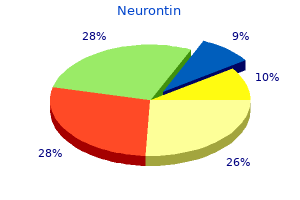
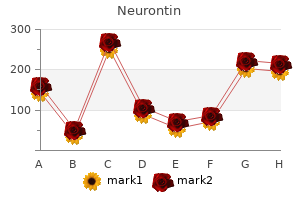
Ecological validity: the extent to which controlled experimental results can be generalized beyond the confines of the particular experimental context of a variety of contexts in the real world treatment enlarged prostate order discount neurontin line. Encounters: One who obtains gratifications through listening to sexual accouters; eavesdropper; the audible counterpart of voyeur keratin smoothing treatment buy neurontin 400mg online. Ecouteurism: Sexual pleasure obtained from sounds or listening to sexual or toilet activities of others medicine ball slams cheap 800mg neurontin with visa. In Britain practitioners are employed within the educational system to deal with psychological issues concerning children in school medications mexico neurontin 400 mg free shipping, and to assess and monitor the progress of children with special needs. They are usually based in Schools Psychological Services or Child Guidance Clinics. In some areas the work is largely taken up with assessing children who are having difficulties in school and making recommendations about which kind of educational setting they need. Other areas have been able to develop much more varied work ranging from therapy with individual children and their families, through curriculum development and teacher training, to consulting with the school on more effective management structures. Effort after meaning:A term used by Bartlett to describe the ways in which individuals attempt to organize Dictionary of Psychology & Allied Sciences 129 their memories, and to make sense of them; if necessary, altering the content of the specific information in order to do so. Ego: One of the three components of the psychic apparatus in the Freudian structural framework. Although the ego has some conscious compo nents, many of its operations are automatic. It occupies a position between the primal instincts and the demands of the outer world; therefore, it mediates between the person and external reality. In so doing, it performs the important functions of perceiving the needs of the self, both physical and psychological, and the qualities and attitudes of the environment. It evaluates, coordinates, and integrates those perceptions so that internal demands can be adjusted to external requirements. It is also responsible for certain defensive functions to protect the person against the demands of the id and the superego. It has a host of functions, but adaptation to reality is perhaps the most important one psychiatric usage of the term should not be confused with common usage which connotes self love. Ego analysis: Intensive psychoanalytic study and analysis of the ways in which the ego resolves for attempts to deal with intrapsychic conflicts, especially in relation to the development of mental mechanisms and the maturation of capacity for rational thought and action. Modern psycho analysis gives more emphasis to considerations of the defensive operations of the ego than did earlier techniques, which emphasized instinctual forces to a greater degree. Ego boundaries: A concept introduced by Federn that refers to the ability of the intact ego to differentiate 130 Dictionary of Psychology & Allied Sciences the real boundaries prevent repressed unconscious material from overwhelming the ego. Egocentricity or egocentrism: A central concept in Piagetian theory, egocentricity refers to the idea that children take their own perspective as central, and tend to assume that other people have the same understandings, motives and needs as the child. When used of adults the term does have implications of selfishness though perhaps in should just imply a delayed cognitive develop ment. According to Piaget, this is a significant part of the child; acquisition of speech; it forms a valuable tool of thought, which the child practices as it performs mental operations on the external world. Ego-coping skill: adaptive method or capacity developed by a person to deal with or overcome a psychological or social problem. Ego-dystonic homosexuality: A psychosexual disorder in which a person has unwanted and distressful homosexual arousal and wishes to acquire or increase heterosexual arousal. Ego ideal: the part of the personality that comprises the aims and goals for the self; usually refers to the conscious or unconscious emulation of signi ficant figures with whom one has identified. The ego ideal emphasizes what one should be or do in contrast to what one should not be or not do. It is not always clear whether this refers to the energy available for ego functions or self-love. Egopathy: Hostile behaviour due to psychopathically exaggerated sense of self-importance. Ego psychology: the study and elucidation of those slowly changing functions known as psychic struc tures which usually shape, channel, and organize mental activity into meaningful and tolerable 132 Dictionary of Psychology & Allied Sciences patterns of experience. The usual structures referred to in this sense are memory, speech, locomotion, cognition, drive, restraint, discharge, and the capacity to make judgements and decisions. Ego strength: Ability to retain reality and manage the forces of the bid and supergo. Egotism: A constant tendency overvalue oneself and therefore to undervalue other people. The differ ence from egoism in that egotists tend not to be interested exploit them. Egotistical attitudes tend to be clearly displayed whereas egoism may need to be concealed to be effective. Einstellung: A term coined by the Gestalt school of psychology of refer to the kinds of mental sets which can influence problem-solving by inducing a rigidity of thought which precludes the perceptions of alternative strategies or solutions. Eidetic image: Unusually vivid and apparently exact mental image, may be a memory, fantasy, or dream. Egotization: the process by which a mental process or function becomes part of the self, structure or deaggressified and desexualized. An emissary of the Zurich school, he gained fame as the first person to be analyzed by Freud in a few sessions in 1907. Later, he became the first chief of the Berlin Psychoanalytic clinic, a founder of the Berlin Psychoanalytic Institute, and founder of the Palestine Psychoanalytic Society. Dictionary of Psychology & Allied Sciences 133 Ejaculatory incompetence (impotence): Inability to reach orgasm and ejaculate during sexual inter course despite adequacy of erection. Elaborated code: A term used by Bernstein to refer to the form of language commonly used by middle class families, characterized by an extensive use of nouns, explanations, and synonyms. This is due mainly to the theory having been associated with the verbal deprivation of class difference in language use, which argue that restricted language use implies restricted cognitive possibilities. Elaboration: An unconscious process or expansion and embellishment of detail, especially with reference to a symbol or representation in a dream. Elation: An effective state of joyous gaiety which, when intensified and out of keeping with life circum stances, is a dominant symptom of mania and hypomania. Elective mutism: A childhood mental disorder in which a child who is able and willing to speak to select persons persistently refuses to speak in other social or school situations.
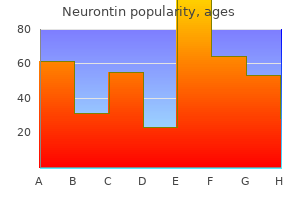
Imputation for incomplete high-dimensional multivariate normal data using a common factor model medicines buy neurontin 100 mg on-line. Psychological interventions for post-traumatic reactions in children and young people: A review of randomised controlled trials medicine university best neurontin 800 mg. The University of California at Los Angeles post-traumatic stress disorder reaction index medicine 44334 cheap 800mg neurontin visa. Multiple imputation for missing data in epidemiological and clinical research: Potential and pitfalls symptoms 5-6 weeks pregnant order 600mg neurontin. The calculation of posterior distri butions by data augmentation (with discussion). Use of multiple imputation to correct for nonresponse bias in a survey of urologic symptoms among African-American men. A unied method for checking compatibility and uniqueness for nite discrete condi tional distributions. Biased estimation of the odds ratio in case-control studies due to the use of ad hoc methods of correcting for miss ing values for confounding variables. In a population-based prospective study, no association between high blood pressure and mortality after age 85 years. Multiple imputation of discrete and continuous data by fully conditional specication. As sessing comparability of dressing disability in dierent countries by response conversion. Stage line diagram: An age conditional reference diagram for tracking development. Least-squares theory based on general distributional assumptions with an application to the incomplete observations problem. Development and validation of a prediction model with missing predictor data: A practical approach. A stochastic multiple imputation algorithm for missing covariate data in tree-structured survival analysis. Bias and eciency of multiple impu tation compared with complete-case analysis for missing covariate values. Avoiding bias due to per fect prediction in multiple imputation of incomplete categorical variables. Strategy for intention to treat analysis in randomised trials with missing outcome data. Some results on reliability for the longitudinal measure ment of change: Implications for the design of studies of individual growth. Imputation and variable selection in linear regression models with missing covariates. Imputation of binary treatment variables with measurement error in administrative data. This page intentionally left blankThis page intentionally left blank StatisticsStatistics C h a p m a n & H a l l / C R C C h a p m a n & H a l l / C R C I n t e r d i s c i p l i n a r y S t a t i s t i c s S e r i e s I n t e r d i s c i p l i n a r y S t a t i s t i c s S e r i e s Missing data form a problem in every scientifc discipline, yet the techniques required to handle them are complicated and often lacking. It also solves other problems, many of which are missing data problems in disguise. Readers less concerned with the theoretical underpinnings will be able to pick up the general idea, and technical material is available for those who desire deeper understanding. Canadian Institute for Health Information 495 Richmond Road Suite 600 Ottawa, Ontario, Canada K2A 4H6 Telephone: (613)241-7860 Fax: (613)241-8120 Web Site: Modified by permission for Canadian Government purposes, by the Canadian Institute for Health Information. As the use of the classification has increased, so, understandably, has the desire among users to contribute to the revision process. The Tenth Revision is the product of international activity, cooperation and compromise. We also thank the Classification Advisory Committee for their time in coordinating and ratifying a thorough review of the proposed changes. There are many possible axes of classification and the one selected will depend upon the use to be made of the statistics to be compiled. A statistical classification of diseases must encompass the entire range of morbid conditions within a manageable number of categories. In the updated classification, conditions have been grouped in a way that was felt to be most suitable for general epidemiological purposes and the evaluation of health care. Policy guidance was provided by a number of special meetings including those of the Expert Committee on the International Classification of Disease Tenth Revision, held in 1984 and 1987. Following suggestions, at the time of development of the Ninth Revision of the classification, that a different basic structure might better serve the needs of the many and varied users, several alternative models were evaluated. It became clear, however, that the traditional single-variable-axis design of the classification, and other aspects of its structure that gave emphasis to conditions that were frequent, costly or otherwise of public health importance, had withstood the test of time and that many users would be unhappy with any of the models that had been proposed as a possible replacement. This provides a larger coding frame and leaves room for future revision without disruption of the numbering system, as has occurred at previous revisions. New chapters have been created for diseases of the eye and adnexa and diseases of the ear and mastoid process. The former supplementary classifications of external causes and of factors influencing health status and contact with health services now form part of the main classification. The dagger and asterisk system of dual classification for certain diagnostic statements, introduced in the Ninth Revision, has been retained and extended, with the asterisk axis being contained in homogeneous categories at the three-character level. This contains the Report of the International Conference for the Tenth Revision, the classification itself at the three and four-character levels, the classification of the morphology of neoplasms, special tabulation lists for mortality and morbidity, definitions, and the nomenclature regulations. It also includes the historical material formerly presented in the introduction to Volume 1. This presents the index itself with an introduction and expanded instructions on its use. Inclusion terms Within the three and four-character rubrics, there are usually listed a number of other diagnostic terms. These are known as "inclusion terms" and are given, in addition to the title, as examples of the diagnostic statements to be classified to that rubric. Many of the items listed relate to important or common terms belonging to the rubric. Others are borderline conditions or sites listed to distinguish the boundary between one subcategory and another. The lists of inclusion terms are by no means exhaustive and alternative names of diagnostic entities are included in the Alphabetical Index, which should be referred to first when coding a given diagnostic statement. This usually occurs when the inclusion terms are elaborating lists of sites or pharmaceutical products, where appropriate words from the titles. General diagnostic descriptions common to a range of categories, or to all the subcategories in a three-character category, are to be found in notes headed "Includes", immediately following a chapter, block or category title. Exclusion terms Certain rubrics contain lists of conditions preceded by the word "Excludes". These are terms which, although the rubric title might suggest that they were to be classified there, are in fact classified elsewhere. An example of this is in category A46, "Erysipelas", where postpartum or puerperal erysipelas is excluded. Following each excluded term, in parentheses, is the category or subcategory code elsewhere in the classification to which the excluded term should be allocated. General exclusions for a range of categories or for all subcategories in a three-character category are to be found in notes headed "Excludes", immediately following a chapter, block or category title. Glossary descriptions In addition to inclusion or exclusion terms, Chapter V, Mental and behavioural disorders, uses glossary descriptions to indicate the content of rubrics. This device is used because the terminology of mental disorders varies greatly, particularly between different countries, and the same name may be used to describe quite different conditions. To enclose supplementary words, which may follow a diagnostic term without affecting the code number to which the words outside the parentheses would be assigned.
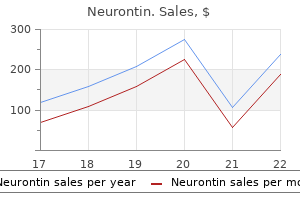
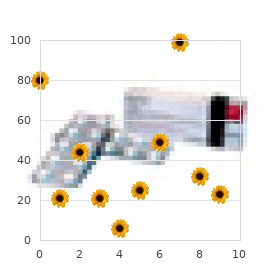
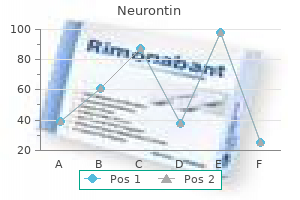
Judgement is so impaired that without admission significant deterioration is likely or appropriate treatment would not be possible 3 medicine dropper order neurontin 800 mg free shipping. Admission would materially help the patient or alleviate the disorder 222 Such an adjournment extends the review of the existing Order but not the life of the Order: the responsible consultant must still complete an Extension Order in order to hold the patient in the approved centre medicine zebra order neurontin with a mastercard. Where the latter is not forthcoming permission has to be sought from the Tribunal medicine 834 cheap 300mg neurontin free shipping. Doctor making recommendation must examine patient within 24 hours of receiving application 3 treatment walking pneumonia order neurontin line. Decision to detain at approved centre to be made within 24 hours (was 72 hours in the 1945 Act) 232 the Mental Health Act, 2008 was rushed through the Dail at the end of October 2008 because extensions of detention as stated on Form 7 (renewals) were deemed to be too imprecise. The Minister designates psychiatric centres to receive persons diverted from the courts. The donor gives an attorney power to make personal welfare decisions on his/her behalf: such power has to be in a form prescribed by the Minister for Justice, the attorney must apply for the power to be registered with the Office of Wards of Court when the donor is/is becoming mentally incapable, certain people must be notified of the intention to register such power, and there are certain grounds for upholding objections to registration. Non-medical 235235235235 the Mental Health Act 2007 amends the the Mental Health Act, 1983 and the Mental Capacity Act 2005. Mental Capacity Act 2005 in England and Wales, (Jones, 2005; Church & Watts, 2007; Church & Jones, 2008; Nicholson ea, 2008) states that a person lacks capacity if at a relevant time he is unable to decide in relation to a particular matter due to an impairment/disturbance of mind/brain. People with capacity can appoint others to make decisions for them if/when capacity is lost (lasting power of attorney). They can also state what treatments they would wish to refuseshould they become incapacitated in the future (advance directives). Should a person lose capacity without having appointed a lasting power of attorney, the Court of Protection may be involved in deciding on capacity and in handling financial/health/welfare decisions. Doctors are able to make decisions based on the Act and will not have to rely on common law. Nevertheless, it was followed by almost doubling of the numbers of compulsory admissions during first 12 years of its existence (Wall ea, 1999) Part I dealt with definitions of mental disorder, severe mental impairment, mental impairment and psychopathic disorders. Guardianship is not commonly used in practice, perhaps because of resource implications. If a detained patient does not want treatment, including medications, after 3 months one must arrange for a second opinion. The patient can be recalled to hospital if deterioration occurs or certain conditions are not kept. In respect of the admission of a child to an approved centre for adults, the following applies: no child under 16 years is to be admitted to an adult unit in an approved centre from 1st July 2009; no child under 17 years is to be admitted to an adult unit in an approved centre from 1st December 2010; and no child under 18 years is to be admitted to an adult unit in an approved centre from 1st December 2011. Hall and Ali (2009) expressed concerns about the changes in the Responsible Clinician role and about the effect this might have on relationships between professions as well as on the role of the psychiatrist. Parental permission does not override the decision of patients aged 16-17 who have capacity. Whilst treatment cannot be forced on a person in his/her own home, that person may be removed to a specified place for 6 hours so that treatment may be administered. Owen ea (2009a) examined consecutive admissions to a London psychiatric hospital (Maudsley) and found that psychotic disorders and the manic phase of bipolar affective disorder were most strongly associated with lack of capacity; in non-psychotic cases, unlike in psychosis, depressed mood was associated with capacity status; insight was the best discriminator of capacity status in psychosis and mania but is less discriminating in non-psychotic cases; and cognitive performance did not predict capacity status in cases with psychosis. In a further publication, Owen ea (2009b) examined 200 psychiatric inpatients using the MacArthur Competence Assessment Tool for Treatment: a quarter were informal (voluntary) but lacked capacity and these people felt more coerced and were more likely to refuse treatment than voluntary patients with capacity; a small number of detained (involuntary) cases had capacity and were difficult to characterise. Adults with Incapacity (Scotland) Act 2000 establishes statutory authority to treat adults who are not able to consent for themselves. Decision making was measured with the McArthur Competence Assessment Tool for Treatment. It was originally exercised by the Court of Exchequer, later passing to the Lord Chancellor, and now lies with the President of the High Court under Lunacy Regulation (Ireland) Act 1871. However, emergency interventions are allowed, 250 permission being retrospectively sought (via the Office of Wards of Court) as soon as is feasible. The decision arrived at is less important than the rationality of the process whereby the individual arrives at the decision. Testamentary capacity (capacity to make a Will at a particular point in time) is not usually questioned. It is important for the assessor to record questions, answers and results of their examination in case of future legal involvement. The amnestic syndrome is very likely to interfere with ones ability to dicate a valid Will because of its effects on recollection and retention. One can have the capacity to make a certain decision and yet, at the same time, not have capacity to make another decision as in the British Park v Park case of 1954 where a man validly married and invalidly made a Will within hours of one another! A doctor may be asked retrospectively to assess if a person, perhaps deceased, had testamentary capacity at the time of making a Will. A similar dilemma exists in Ireland in the case of dementia sufferers who lack capacity who do not qualify (or cease to qualify) for involuntary admission under the Mental Health Act, 2001 but who cannot be allowed to simply walk out of the hospital. A retrospective study of 115 consecutive psychiatric admissions of people who lacked capacity to make treatment decisions (Owen ea, 2009c) found that 83% of those who regained capacity agreed retrospectively with the decisions made on their behalf. The case eventually ended up in the European Court of Human Rights which ruled that the detention constituted deprivation of liberty under Article 5 of the European Convention on Human Rights. It would have been better to have used the mental health legislation if the patient had a mental illness and not to admit as a voluntary patient when the person lacks capacity. Code of Practice Relating to Admission of Children under the Mental Health Act 2001. It is a measure of the level of agreement between 2 sets of observations, agreement being usually measured by the correlation coefficient (good reliability if high and positive: +0. They should not be interpreted in isolation in individual cases, but rather they should be viewed within the context of the case as a whole. The main applications of measuring instruments are case identification, standardisation of psychiatric interviews, and serial measurement of symptom severity. Ecological validity refers to a growing awareness of the need to design tests the better predict real-life behaviour and functioning. Sensitivity (true positive rate): proportion of true cases (identified using criterion instrument) identified as cases by a novel instrument.
Purchase 100mg neurontin with amex. Home Remedies For Heroin Withdrawal.



